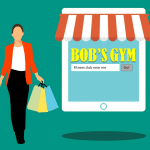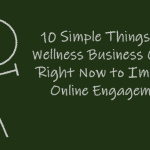You gotta love flyers: lots of marketing potential at very little cost. These one-page printed ads land directly in the hands of your potential customers.And the low cost makes them a great way to promote your services while testing different copy and design ideas to see what works best.
Here’s our list of field-tested tips for successful flyer marketing:
1) Work backwards to the action you want
Determine the response you want when people read your flyer. Is it a phone call? A visit? An email sign-up?
Then work backwards to design the offer around that action.
Let’s say your goal is to get potential customers to pay a visit to your wellness center or health club.
A flyer inviting people to a complimentary talk by a local healthcare professional at your location will usually get more potential customers through the door than a flyer that promotes a membership offer.
Why? Because the event invitation appeals to people in several different stages of the buying process. A membership offer, or a “free tour” offer, appeals mainly to those in only one stage of the buying process.
2) Write a short and sweet headline that grabs attention
The original headline for a downtown health club’s flyer:
“We invite you to play as hard as you work”
The improved headline:
“Work…Then Work Out!”
For a wellness business focused on breathing and energy work:
“Breathing. Simple but not easy.”
3) Create urgency
Use a time-sensitive offer, limited availability, discount or other special terms:
“Only fifteen spots available”
“Bring a friend and save $20%”
“Special prices end Sat., 3/15”
4) Write persuasively
Bland descriptions bore. They don’t entice.
The original list of services on a gym’s flyer:
“Facility Services:
Indoor pool
Indoor track
Racquetball
Basketball
Massage
Lockers”
etc.
Rewritten:
“Get your midday stress break on cool indoor courts”
“Head back to your office refreshed by our sparkling spa”
5) Be specific
Vague generalities don’t grab the reader’s interest.
Say you provide clients with several sheets of paper containing exercise tips. Describe it as a “workout guide” rather than a “handout”.
Instead of “We offer programs and resources for all”, spell out who “all” is. Moms? Dads? Athletes? People who hate to sweat? Get specific.
6) Describe the benefits of your services
Assume that potential customers are NOT already familiar with the benefits your wellness business offers.
The original service description:
“We offer medical massage, yoga therapy, and spinal adjustment”
This copy assumes that your potential customer already knows WHY they would benefit from medical massage or spinal adjustment or energy. Bad assumption!
Revised:
“You’ll discover painless stretches that promptly ease back pain.”
7) “We” should not be the center of attention
Focus on the customer by using “you” and “yours”. Don’t blather on about your business with copy that starts with “I”, “we”, and “our”.
Customer-oriented:
“You’ll learn five easy ways to love eating well.”
We-oriented:
“Our great team does a wonderful job of sharing our fitness expertise”
8) Tell people exactly what you want them to do next
Spell out who, what, when and where:
“Sign up online now”
“Call today”
“RSVP by Sat., 3/15 for free seminar (snacks served!)”
9) Use short and directly relevant customer comments
A great quote:
“If you ever eat when you’re mad, not hungry, this class is for you!”
On the other hand, omit generic and vapid comments:
“Thanks for a fabulous time!”
10) Flyers have a front and a back
Consider using the back of the flyer for a map, a customer story, a “did you know” quiz or other valuable information that will engage potential customers.
11) Do we really need to shell out for color printing?
Nope. Well-designed black-and-white flyers can be extremely dramatic. You can also use shades of gray instead of printing in color.
If you do want to print in color, check out www.docucopies.com. We’ve had good reports from clients regarding quality and turnaround time.
12) Color on the cheap
Black text printed on colored paper is a very inexpensive way to add color to your flyer.
Yellow paper is always a good choice. Light and medium pastels and neons can also work. Avoid dark colors like red, brown, and dark blue, since black text won’t show up well.
13) What’s the best size for flyers?
Most flyers are rectangular – either 8-1/2 x 11 or a half-sheet, 4.x25 x 5.5.
However, feel free to experiment. Triangles, quarters, or thirds can also be eye-catching. Try a landscape orientation rather than a portrait orientation.
14) Test, test, test
Remember that the measure of a flyer’s success is the number of people who take the next step you’ve spelled out for them.
Test different versions of your flyer – headlines, paper color, incentives – and use the elements that generate the highest level of response.
15) Don’t get too fancy with fonts
Use no more than three different fonts (not counting bold or italic versions of the same font)
Use a dramatic and bold font for headline
16) Images catch the eye
Use a relevant graphic, not a generic stock image
Locate the graphic on the top half of the flyer
Have the most important content next to graphic
17) Use visual dividers
Break up text with white space, bullets or other visual “dividers”.
Avoid long paragraphs of text.
Use boxes and borders to highlight different sections of content
Turn some content at a slight angle to provide visual interest
“Break the borders” of the page to create interest
18) Always give your flyer the five-steps test
If you take five big steps away from your flyer, is it easy to read?
19) Proofread, please
Use correct spelling and grammar. Proofread every single word for typos, spelling errors, missing words, etc.
20) Verify contact info
Call the phone number as written, type the web address into a browser, double-check the street address.
21) Avoid flat stacks of flyers
Use a 8.5″x11″ vertical display stand like this one for in-store flyers. A stack placed flat on the counter is harder to see.
22) Newspaper holders, yes. Mailboxes, no.
Never place flyers in mailboxes. It’s illegal. You can, however, place them in newspaper holders attached to mailboxes.
23) Audit paid flyer distributors
if you pay for distribution, keep ’em honest by auditing some areas to make sure flyers were actually distributed.
Spot-check dumpsters and recycling bins, too.
24) Tap vendor sales reps to help distribute
Give them a stack of flyers or email a PDF version that they can forward.
25) Use your team’s network of personal contacts
Want to place flyers in doctor’s offices? Have employees contact their personal physicians and those of their family members.
26) Co-market with businesses that have a similar customer base
The response rate will be much higher than the usual 1% rate when you blanket a neighborhood or zip code. For example, they can place flyers in shopping bags or display them on counters.
27) Remember to replenish!
When you market through other businesses or organizations, remember to replenish their flyer inventory.




